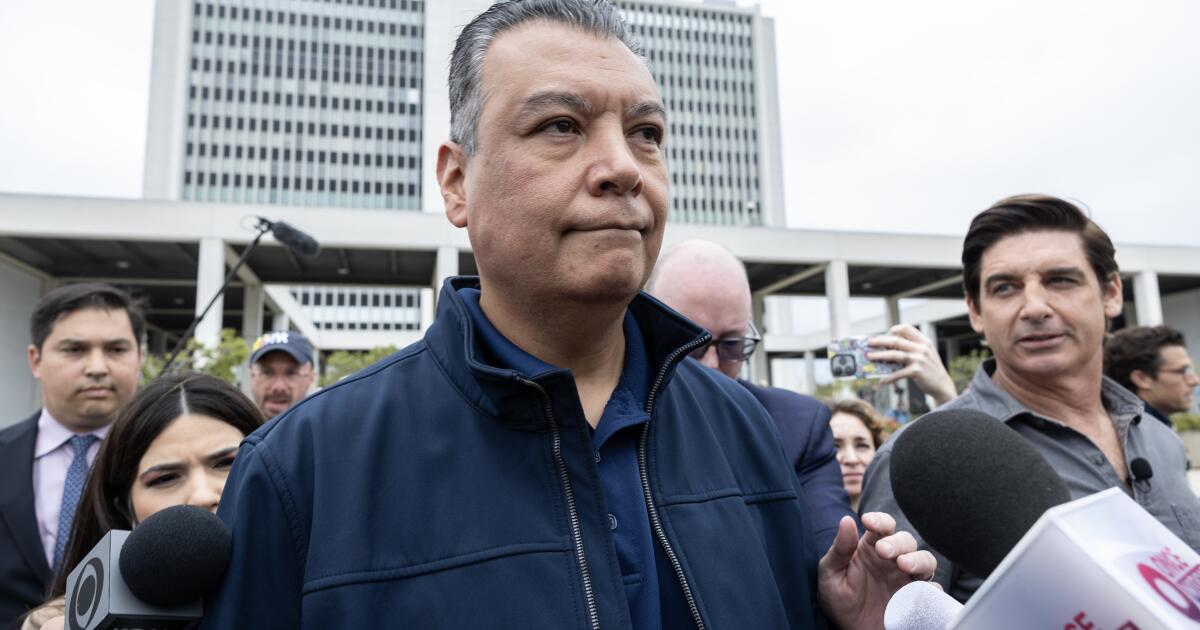Trump’s war on Latinos reaches a new low in abuse of Sen. Alex Padilla
The U.S. population includes an estimated 65.2 million Latinos, nearly a quarter of whom call California home. For over a century, Latinos were absent from the state’s two U.S. Senate seats. In 2022, Sen. Alex Padilla reversed the willful neglect of Latino senatorial candidates by both major political parties, winning 61.1% of the vote, more than any other statewide candidate, including Gov. Gavin Newsom.
On Thursday, in the midst of the Trump administration’s largest immigration raids to date, Padilla was forcibly removed at a Department of Homeland Security press conference in his hometown, Los Angeles. Manhandled, for daring to exercise his congressional responsibilities. Pushed out of a job-related meeting for asking a question. For many Latinos, the abhorrent treatment of Padilla by the Trump administration is emblematic of a shared grievance: being pushed out of conversations about our lives, our families and our futures.
The Trump administration’s immigration raids are squarely a Latino issue. Not because immigration is a Latino issue — all issues are Latino issues — but because Trump’s immigration enforcement is and has always been racially motivated. From Trump’s campaign announcement in 2015, calling Mexicans rapists and criminals, to his fixation with building a wall across our southern border and having Mexico pay for it, to his 2024 campaign focused on falsehoods about immigrants and criminality, the central narrative has been “us” versus “them.”
Immigration is a concern in every city and state, yet Trump’s immigration enforcement seems to be exclusively focused on Latino communities. In Los Angeles, Trump’s raids are explicitly targeting Latino-majority neighborhoods and cities including Westlake, Paramount and Compton, going beyond data-informed enforcement actions to the racial profiling of Latinos near schools, tending to errands like getting a car washed or sitting in a church parking lot.
Over the last week, Los Angeles has been ground zero for Trump’s federal overreach. Padilla’s silencing and removal follow refusals to admit four U.S. House representatives at the Los Angeles federal detention center on Saturday and three representatives to the Immigration and Customs Enforcement processing center in Adelanto on Sunday.
While immigration raids raise serious policy and human rights concerns, the unequal treatment of Latino congressional leaders by the Trump administration represents a different kind of hazard: a test for control of our democratic republic.
America has three co-equal branches: legislative, executive, judiciary. This system of separation of powers and checks and balances is designed to prevent tyranny and ensure a balanced government. For the last five months, the Trump administration has upended our system of governance.
The Trump administration bypassed Congress’ budgetary actions by eliminating foreign aid. Trump officials willfully ignored judicial orders. They’ve blocked sitting members of the House and Senate from entering federal buildings, obstructed them from conducting oversight and undermined their inquiries.
Like Trump’s immigration enforcement actions, the administration’s overreach is racially motivated. Latinos have long expressed that no one is listening to their needs — that they are left out of the conversation and never at the table where decisions are being made. Research has made clear that Latinos bear the brunt of underrepresentation across important societal institutions such as academia, private enterprise, philanthropy and news media. The list goes on.
Unfortunately, when Latinos achieve positions that ought to wield power — such as Padilla’s ascent to the Senate — the positions themselves tend to be diminished, so that — again, like Padilla being silenced at a press conference — the Latinos who gain prominence are denied the power that non-Latinos enjoy in parallel positions. This week’s events provide a new chapter in the diminishment of Latino agency and dignity; members of Congress were denied entry to do their jobs, and in the case of Padilla, forcibly removed and detained.
One thing is consistent: the repeated dehumanization of Latinos and their needs. Latinos are not a monolith, but the Trump administration is surely treating us as such. His administration has rolled out a carte blanche attack on Latinos. From Latino community members being stalked and apprehended in Home Depot parking lots, at places of worship or their children’s school graduations, to targeted attacks on the sustainability and operations of Latino-led nonprofit organizations, to the physical assault of a U.S. senator. The subjugation of Latinos is currently on full display in Los Angeles, a region that fuels the world’s fourth-largest economy (California) and is the global epicenter of media and entertainment. The absence of meaningful Latino participation in shaping narratives, trends and the public imagination is cause for concern.
Any conversation on the fragility of American democracy, the resurgence of fascism and authoritarianism and the future of the Constitution is, inherently, a discourse about Latinos — and about all Americans. So long as Latinos remain silenced, ostracized and relegated to the periphery in conversations about the future of this nation, that future remains bleak. The test of how America responds in real time to the wholesale attack on its second-largest demographic group is now a shared assignment. And the group’s leader is Padilla.
Sonja Diaz is a civil rights attorney and co-founder of the Latina Futures 2050 Lab and UCLA Latino Policy & Politics Institute.

